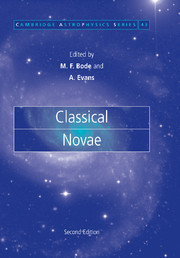Book contents
- Frontmatter
- Contents
- List of contributors
- Preface to the first edition
- Preface to the second edition
- List of symbols
- 1 Novae: an historical perspective
- 2 Properties of novae: an overview
- 3 The evolution of nova-producing binary stars
- 4 Thermonuclear processes
- 5 Nova atmospheres and winds
- 6 Observational mysteries and theoretical challenges for abundance studies
- 7 Radio emission from novae
- 8 Infrared studies of classical novae
- 9 Optical and ultraviolet evolution
- 10 X-ray emission from classical novae in outburst
- 11 Gamma-rays from classical novae
- 12 Resolved nebular remnants
- 13 Dust and molecules in nova environments
- 14 Extragalactic novae
- Object index
- Subject index
6 - Observational mysteries and theoretical challenges for abundance studies
Published online by Cambridge University Press: 10 October 2009
- Frontmatter
- Contents
- List of contributors
- Preface to the first edition
- Preface to the second edition
- List of symbols
- 1 Novae: an historical perspective
- 2 Properties of novae: an overview
- 3 The evolution of nova-producing binary stars
- 4 Thermonuclear processes
- 5 Nova atmospheres and winds
- 6 Observational mysteries and theoretical challenges for abundance studies
- 7 Radio emission from novae
- 8 Infrared studies of classical novae
- 9 Optical and ultraviolet evolution
- 10 X-ray emission from classical novae in outburst
- 11 Gamma-rays from classical novae
- 12 Resolved nebular remnants
- 13 Dust and molecules in nova environments
- 14 Extragalactic novae
- Object index
- Subject index
Summary
Introduction
Unlike core collapse supernovae, we have no observation of the initial moments of a classical nova outburst. But, as described elsewhere in this volume, we can reconstruct – at least in a broad sense – the explosive and mixing phenomena because of the comparative simplicity of the ejection process. The thermonuclear runaway is the foundation of our understanding. Yet many details of the dynamics remain to be explored and some of the signposts for change are observational since at the moment of ejection, the nucleosynthetic products are contained in – and expelled with – the ejecta. They provide an interpretable record of the stages of the explosion that are otherwise inaccessible to direct observation. The ambiguities of this record, understood only through modeling, will be the subject of our discussion in this chapter.
Decoding the abundance patterns in various subclasses of novae and individual objects has proven a great challenge over the decades since the first edition of this book appeared. Considerable progress has been made in obtaining consistent pictures from a variety of analyses, as we will discuss. Here we will highlight a few of these methods, examine their various limitations and systematic uncertainties, and indicate some directions that new methods of spectroscopic analysis and theoretical modeling can take to improve the picture in the near and long term.
- Type
- Chapter
- Information
- Classical Novae , pp. 121 - 140Publisher: Cambridge University PressPrint publication year: 2008
- 22
- Cited by



